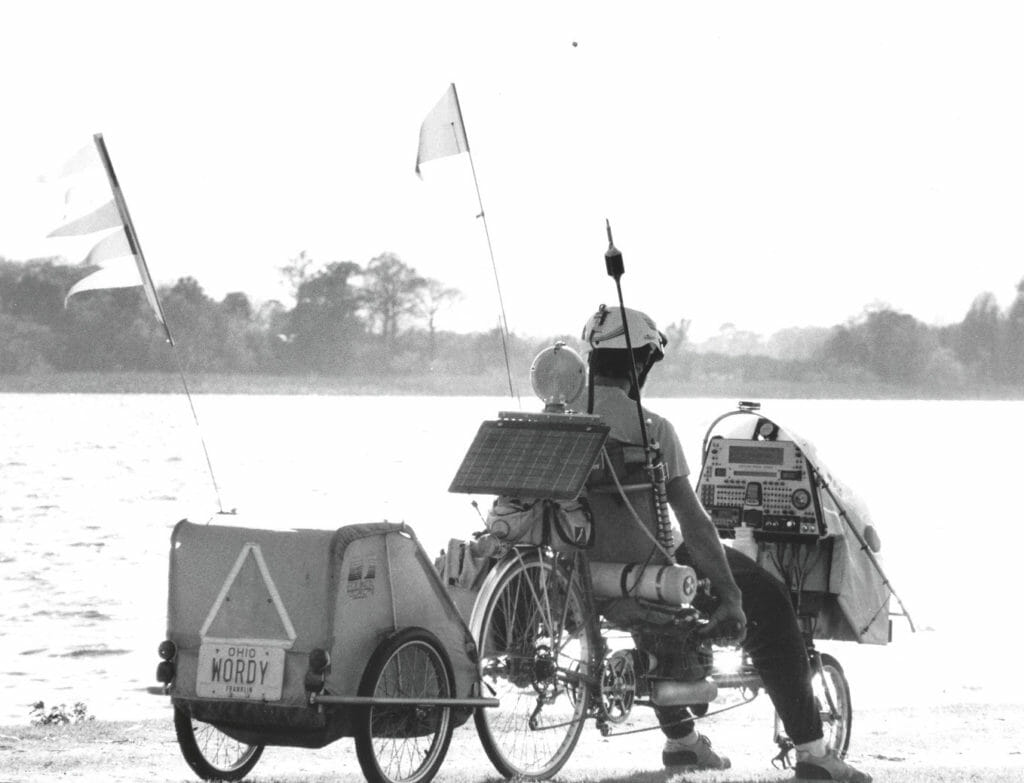
Nickel Generators
Photo above – Winnebiko II circa 1988, photo by Dan Burden
In 1983, I abandoned all pretense of responsibility and hit the road on a bicycle. This was deeply alarming to my parents, since I was now 30 and a suburban homeowner; even though I was barely scraping by as a freelance writer, at least it was amidst the trappings of normalcy. But when I sent them this article in Online Today announcing my upcoming “Computing Across America” adventure, my mother’s first response was…
“What’s the matter, Steve? You going to be a bum all your life?”
I often chuckled at that over the years, but of course she was right. From the perspective of the American Dream, I had gone terrifyingly astray.
Fast forward to 2011. I drive a big boat instead of a bicycle, with more upscale trappings… but still none of the security that has kept old friends slaving at jobs for almost 3 decades, building nest eggs for retirement. With the turbulence of this economy, we have no idea what any of that means, but the fact remains: I’m winging it, and have no illusions about a financial cushion.
This topic comes up frequently, and not only in the context of my own incompetent “financial planning” that has included some spectacularly bad decisions. I am often asked how I can afford to work for years on geeky projects, and if I’ve given any thought to what will happen in my dotage.
Well. Let me tell you about nickel generators.
First, I must credit the originator of that term: Don Lancaster, writing in the Incredible Secret Money Machine back in the 1970s. This influential work urged early geeks to spin off their projects, productizing them on a simple scale without the overhead of patents or corporate structures. When some company copies you, the agility of working on your own keeps you out in front, already releasing the next cool thing. I’m not hitting all the high points here, but his “nickel generator” term has stuck in my mind over the years as the label for a micro-scale business with minimal investment.
The beauty of this concept is that you can deploy many such things in parallel… to the point where the failure of one is no big deal. Typical business models do not allow this luxury; if you’ve invested everything in a startup and it fails, then you have a life-changing financial crisis. But nickel generators come and go in response to current interests, niches of opportunity, rare skills or tools, and any differential between cost and market price.
This post is a quick tour through some of mine, illustrating the variables and showing how they are derived naturally from activities that interest me. I’ve never been good at doing things I don’t enjoy to pay for things I didn’t want after all, so have spent much of my life trying (not always successfully) to make a living on the spin-offs of passions without trashing them in the process.
A related issue, as valuable as generation, is the plugging of nickel-leaks. I’ll give a few examples of this as well… attempts to control what someone once called the latte factor that chips away at your finances, day after day, quickly adding up to Real Money.
Investments
First, let me dispense with this one. Conventional wisdom has always held that one should park funds in a suitably diversified portfolio that matches your risk tolerance and investment goals. Not counting the halcyon days of the dotcom boom when it was easy to mistake a bull market for one’s own brilliance, I have little but uneasiness around this whole topic. Some have done very well; I have not… when I had some money from shutting down the old family home, I fancied myself a contrarian and took action based on Peter Schiff’s Crash Proof, betting it all on “non-dollar-denominated, dividend-earning stocks” brokered by his firm.
What a disaster, despite the seductive logic of the book. When things went south in ’08, there was a “paradoxical flight to treasuries,” and I got destroyed (and he twisted the knife by crowing “I told you so” on every page of his awful follow-up, Bull Moves in Bear Markets). Subsequent experiences with that firm were just as bad, only more slowly… and I finally realized that I had let myself be convinced that they were looking out for my best interests. I bailed with the dregs, wishing that I had not let them talk me out of AAPL back when it was under 100 with the warning that it would crash when Steve gets sick again. A checking account would have been a vastly better investment.
The take-away lesson in all this is that unless you have money you don’t mind losing (as well as a strong interest in the ongoing research and monitoring), this stuff is dangerous as hell. I have friends who are passionate about this and do very well… but in an unstable global economy, is it wise to let people you have no reason to trust advise you about investment in companies over which you have no control? The long-term viability of the dollar is dubious, but stocks are still high-risk gambles.
Limping away from all that with my tail between my legs, I recognized my fundamental mistake. I should have used that brief illusion of security to invest in something that I could understand and manage myself… like nickel generators! Let’s look at a few.
Kayak Goodies
One day a few years ago, I was staring at my kayak, Bubba, sitting on the concrete floor of my lab. Rodents had made a mess of it, and it lay crumpled against dirty concrete. I did a quick web search on kayak stands and was surprised to see them over $100.
Well, that’s silly. I took some PVC scraps and conjured something like the classic camp stool, with scrap fabric and sewn tunnels making the “seat.” It worked fine, and I asked my fabrics guru to help with proper materials that would stretch and not hold moisture against the hull. Once we had it, I wrote an article about Homebrew Kayak Stands for my website, giving the full design and mentioning, almost as an afterthought, that if you don’t want to deal with the tricky process of sewing the mesh slings (the only hard part), we’ll sell you a pair.
Orders have been trickling in for years. It’s not as trivial as it looks, and we have gone through a number of revisions driven by design refinements, production challenges, available materials, and so on. But this is a great example of a low-stress micro-business.
The only “overhead” is a web page with PayPal button, and shipping is simple enough that I’ve done it from the boat and development lab (and had it done by our house sitter while cruising in 2008). We have no illusions of owning the market, getting big, or offshoring production to allow the huge profit margins needed for a distribution network. With the full design on my site, I’m not stressed about anyone copying it (I even give email advice when folks want to roll their own). Easy… and we also have a related “product line” in the form of kayak paddle bags and leashes.
If I was trying to make a living at this, I’d be on the streets. But as a nickel generator, it contributes its share.
Medical Chests
A more recent addition to the Nomadic Research Labs empire has resulted from teaming up with my new partner, Kirsten… who happens to be a nurse. Like most cruisers, I had spent a fair bit of money on a medical kit, but when she looked it over she was not at all impressed. I had already been muttering about it not being waterproof, and with her added comments about the contents we realized that we had found a niche.
We researched sealed enclosures and found some well-suited to the task, and she set to work specifying supplies for our first product in the Expedition Medical Chests line. We published a booklet clearly explaining the basics of wound care, and aimed the whole thing at voyagers and others who would like to find a stash of ER-grade supplies dry and usable after a knockdown, hurricane, or other emergency.
A key issue is pricing, so we kept it tight with kits going for approximately the retail price of box and contents… counting on volume purchases of supplies for our profit margin. This works since we’re small and not trying to leave room for dealers (a recurring theme!). Almost immediately, folks started asking about a “mini” version for day sailing or smaller boats, so we added that to the product line. There are also two other models waiting in the wings, as well as a few accessories like empty packaging and refills. I set up a Drupal site for all this, where Kirsten writes a marine medical blog, and they are now in their own department in my little online store of technomadic goodies.
The beauty of this as a nickel generator is that it can be operated by a future manager; we’re carefully documenting all the processes such as book printing/binding, box labeling, content packing, and shipping.
Publications
Ideally, spin-offs should painlessly fall out of the things we do with our passions, and product development is anything put painless. I’ve stopped short of producing electronic products more than once, intimidated by the complexities of manufacturing, version control, documentation, tech support, and so on. Most of my life, I have depended on writing as a “technology transfer” vehicle, and this is still the default.
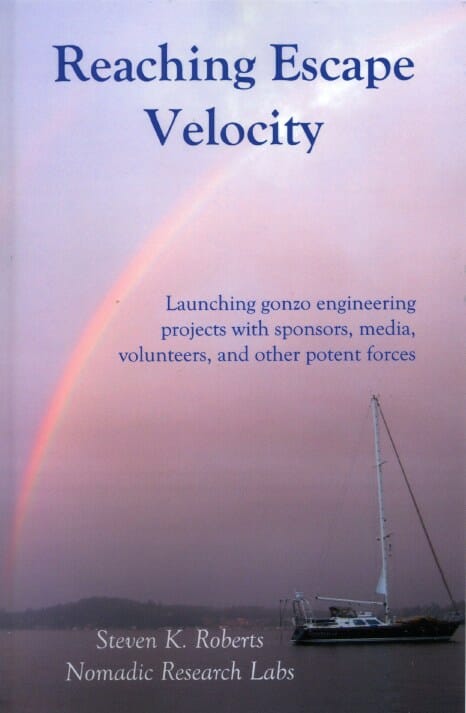
Reaching Escape Velocity is about the art of doing absurdly complex projects with the help of sponsors, volunteers, and media.
Making money at it is a complex subject, and the publishing environment has been completely turned on its head over the past few years. In the book department, I have grim memories of all but Reaching Escape Velocity, which I did with CreateSpace, a tool for publishing on demand that propels manuscripts from PDF to reality (including Amazon) with a minimum of stress. MagCloud is a similar tool for magazine-format full-color projects, and these are just my two favorites in a fast-growing industry that is mercifully reducing the need to deal with publishing houses.
But books are still daunting projects (even little ones like this 72-pager). At the other extreme is what I’m doing right here: blogging and posting articles online, with a few ads sprinkled about. Affiliate links have never been a huge win for me in pure financial terms; the greater value of online publishing is measured in soft dollars like keeping in touch with a community of involved readers who always seem to know the answer when I have a question.
More recently, I’ve been trying something new… a monthly PDF called the Nomadness Report, available by subscription (or as a PDF compilation of all 22 back issues). Subtitled “A Compendium of Boat Hacking and Gonzo Engineering,” this is hitting its stride with technical details of the project that would overwhelm this more general blog. I’ve been encouraged by the steady arrival of new subscribers (which adds energy to the writing), and the plan is to compile these into eBooks and print editions, further adding to the product line.
Additional publications include Winnebiko II posters, PDFs of design packages or otherwise unpublished tales, previous books and print journals, and more coming down the pike.
Other Nickel Generators
There are quite a few more, which I’ll mention briefly… starting with the selling of time, which doesn’t scale well. Consulting and freelance writing yield good income on occasion, but are limited by available hours and energy. For a while I was on the public-speaking circuit, making cross-country cruises with the bike in a mothership, but that faded along with the easy cash of the dotcom era and the technological currency of BEHEMOTH.
I’ve also done well with years of tonnage-reduction on eBay, though that is a lot of work and will eventually asymptote to zero when I’ve gotten rid of everything I can. (Hey, want some stuff?)
But some stuff can pay off over and over. Have a rare or highly useful tool that people only need on rare occasions? Put up a rental page, like we did with the boat trailer that came with a Cal 2-29 sailboat that we bought back when the “two-boat solution” looked like it would cure relationship woes. Trailer rental is not an easy business, but it’s already brought in more than half the cost of the boat.
In addition, there is the aforementioned online store, which I opened with high hopes a couple of years ago. It works fine, but requires more ongoing maintenance than it’s getting in the form of inventory building, creating pages, and so on. In practice, this is not much different from the process of marketing my own stuff, so one of this year’s tasks is to get a bit more serious about it…
The most painless of all nickel generators, of course, are those that you can simply deploy and forget. Google AdSense, Amazon affiliate, eBay partner links, and other programs… as long as you don’t clutter your pages with too much of this stuff, these can generate an ongoing trickle forever. It’s not terribly exciting, at least at my level, since I don’t have a mega-traffic site and people are less fascinated by every clickable link than they were in the last century… but over the years, it adds up.
And that’s really the whole point here. Lots of easy micro-businesses, even if they only generate $10/month, combine into a resilient machine for cash-flow generation. Now let’s wrap this up with a quick look at the other half of the equation, which is every bit as important!
Plugging the Leaks
We’ve all done it: gotten into a daily routine that keeps a steady drain of cash going out, then suddenly punched the numbers into a calculator and realized that it’s a scary percentage of our annual income. At the current cost of cigarettes, apparently, a pack-a-day habit is now over $2500/year. What about the more hip addictions, like espresso? A daily latte at a drive-through is well over $1000/year… that would pay for a very nice countertop Italian machine with killer crema, as well as a steady feed of decent Sumatran to pump through it.
Do you have credit-card debt? That is just plain nasty; I don’t carry a balance, but I told BofA to take a hike when they jacked my interest to 26% with a warning that if I were ever late on a payment it would go to 29.99%. Criminal! When you add mortgages, car payments, and student loans, it’s a wonder anyone can crawl out of the debt hole without forgetting all this self-indulgent nickel-generation nonsense and getting a real job.
In the cruising scene, the two obvious biggies are avoiding boat loans and learning to do most of the work yourself. The basic rule of boat acquisition should be: if you can’t afford it out-of-pocket, you can’t have it. That’s painful, with the nautical lust inspired by Yachtworld, but monthly payments are anathema to the voyaging lifestyle (taxes, insurance, and moorage are bad enough). As to the DIY stuff, I’ve learned the hard way that not all “professionals” can be trusted. Unless something requires esoteric tools or arcane knowledge, I figure out how to do it myself… even though it takes longer. This sealed off another stream of leaking money, and I’m learning the skills to have a good chance of fixing my own boat Out There where hiring people may not even be an option.
There are plenty of subtle nickel leaks, too. For years, my favorite default dinner was the AFP, or Augmented Frozen Pizza. I’d take a DiGiorno and layer on all sorts of good stuff, including pesto, sundried tomatoes, decent meat, fresh veggies, quality cheese… and feel smug about it. But recently Kirsten and I started making our own crust using the simple no-knead technique detailed in Cooking for Geeks, knocking $5 off the cost of every one (and it’s better). We have chickens and a garden, and are learning some of the classic techniques of food preservation.
Aboard Nomadness, I grow sprouts, make bread, and brew beer using the easy Mr. Beer kit (which, at 2 gallons, scales well to life on a boat). I have a very long way to go with such skills, and am a total newbie at fishing… but every time I bite into something yummy that didn’t involve paying for a long industrial supply chain, I feel both healthier and financially virtuous.
I mention all this in the context of nickel generation because both sides of the equation are equally important. The less money you spend, the fewer nickel generators you need, and the more energy you have for the things you really want to do. Spelling it all out like this sounds ridiculously obvious, but I see folks in the debt trap, struggling to combine a full-time job with the passionate pursuit of the cruising lifestyle, and I realize that I would simply not be capable of doing it. It’s overwhelming already, and I live aboard about 75% of the time.
This has been a long post, but an important one… it’s easy to consider financial aspects as uncomfortably personal, and refuse to talk about them. But the tools for deploying nickel generators are widely available, and the need is great. If you have a passion that can be mined for spin-off products, the gift of gab that turns your words into cash, a scarce piece of equipment that can generate income, a skill that everyone needs, or a chunk of capital that can be invested into inventory instead of mysterious “securities,” then you might be able to sidestep the treadmill and increase your ability to weather both personal and global economic storms… having more fun in the process.
Cheers!
Steve


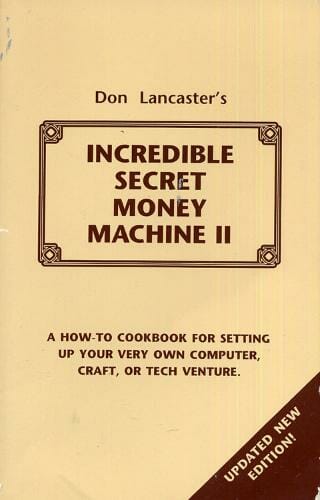
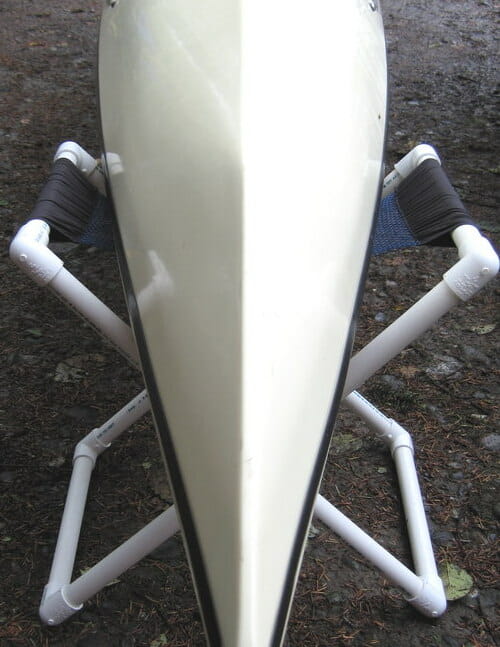

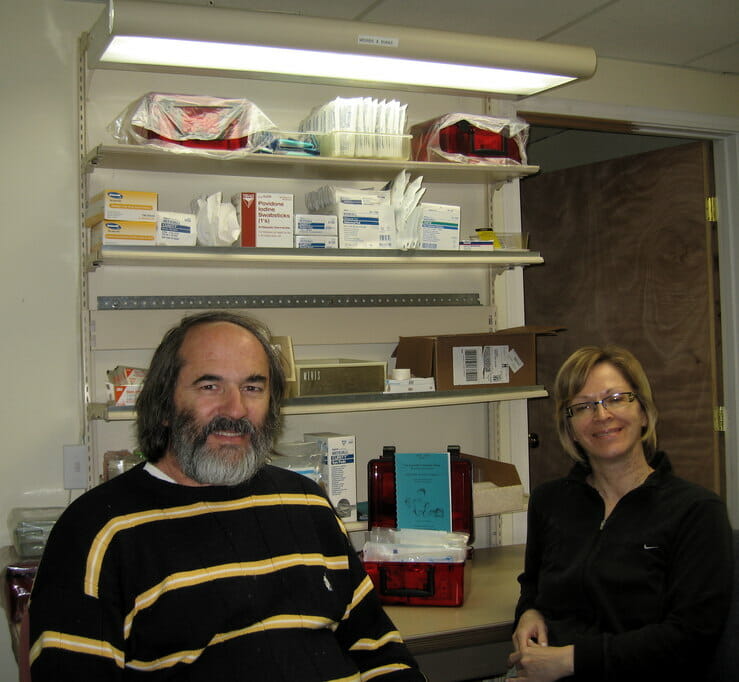
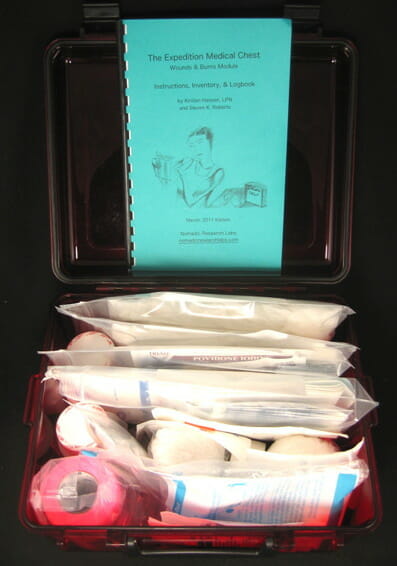
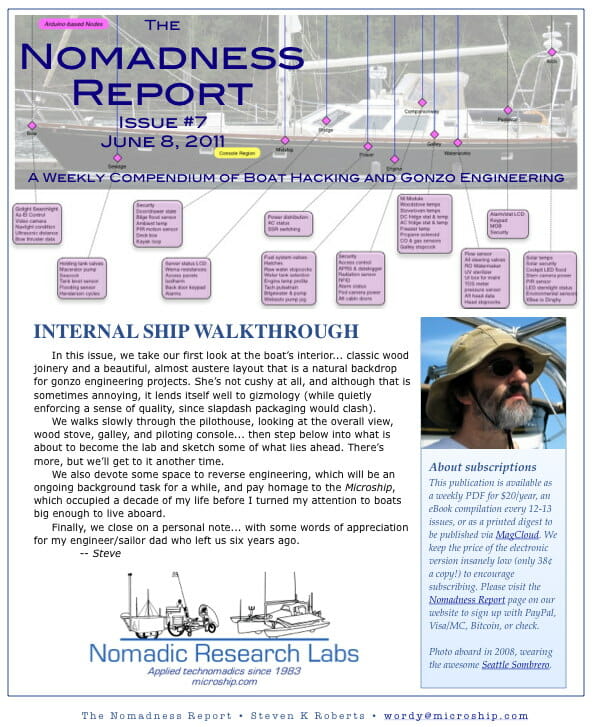


Great post! As to the cruising lifestyle and stopping the nickel leaks, I have a couple of things to add starting with fuel. Diesel is a huge expense, and planning trips around calendars almost surely leads to excessive diesel consumption. On the other hand, waiting for the right conditions and actually SAILING our boats can save a lot of moolah, not to mention being infinitely more fun. Sure, I only burn a quart per hour, but Nomadness burns nearly a gallon/hr so a day of motoring can easily cost $30/day which adds up faster than mochas, merlots, or microbrews!
Another thing I would add for northwest sailors, is either joining a yacht club to get reciprocal moorage or (as I have done) purchasing a state park pass. I am more the camping type than yacht clubber, but either one will reduce your transient moorage costs. For my 29 footer, it cost me $100. This is a great way to go; buoys in marine parks are $10 or $15/night which can add up. Of course, anchoring is best, but with my injured back, I suspect I won’t be doing a lot of that this year.
The last thing, I will mention is choosing kerosene for cooking. It is incredibly cost effective! I am using Jet-A fuel (clean and hot!) purchased from the sump at the local airport. I estimate spending about $5 for the season or $20 for the entire year! Once I install the kero cabin heater, I will save a lot on electricity at the dock during the winter months too. See you out there! Catch me if you can! ~sky
Hey Sky, with regard to diesel, we have a biodiesel workshop coming up in August.
Although our processor makes 120 litre batches, you could learn to easily make “blender batches” of a litre or so for the low-wind days… and you’ll be contributing to one of my “nickel generators.” 🙂
Better yet, why don’t you convert that puppy to run on waste vegetable oil? This is more trouble than biodiesel for short runs (like in and out of harbours), but is ideal if you’re going to be dieseling for more than a half-hour or so.
Excellent post! Although I would love to live on a boat my husband doesn’t do well (seasick) so we are currently researching countries we can live in and live a healthier life.
My husband works 10+ hours per day just to keep up with his workload and I work from home writing, online course programming, and working on my websites which are my passion and what I hope will become an additional source of income for us.
Our house is for sale and once that sells, we’ll be selling off most of our belongings in preparation for a simpler lifestyle.
I have bookmarked your blog for future motivation and encouragement.
I’ve enjoyed catching up with your blog and this post has had many jewels. I’ve already looked into the SproutPeople.com website (I was considering moving to a Raw Food diet). Sprouting looks to be an excellent way to eat healthy, minimize waste, practice sustainable food consumption, and enjoy greater health. Thanks for the reference.
I’ll work more later on the beer brewing…